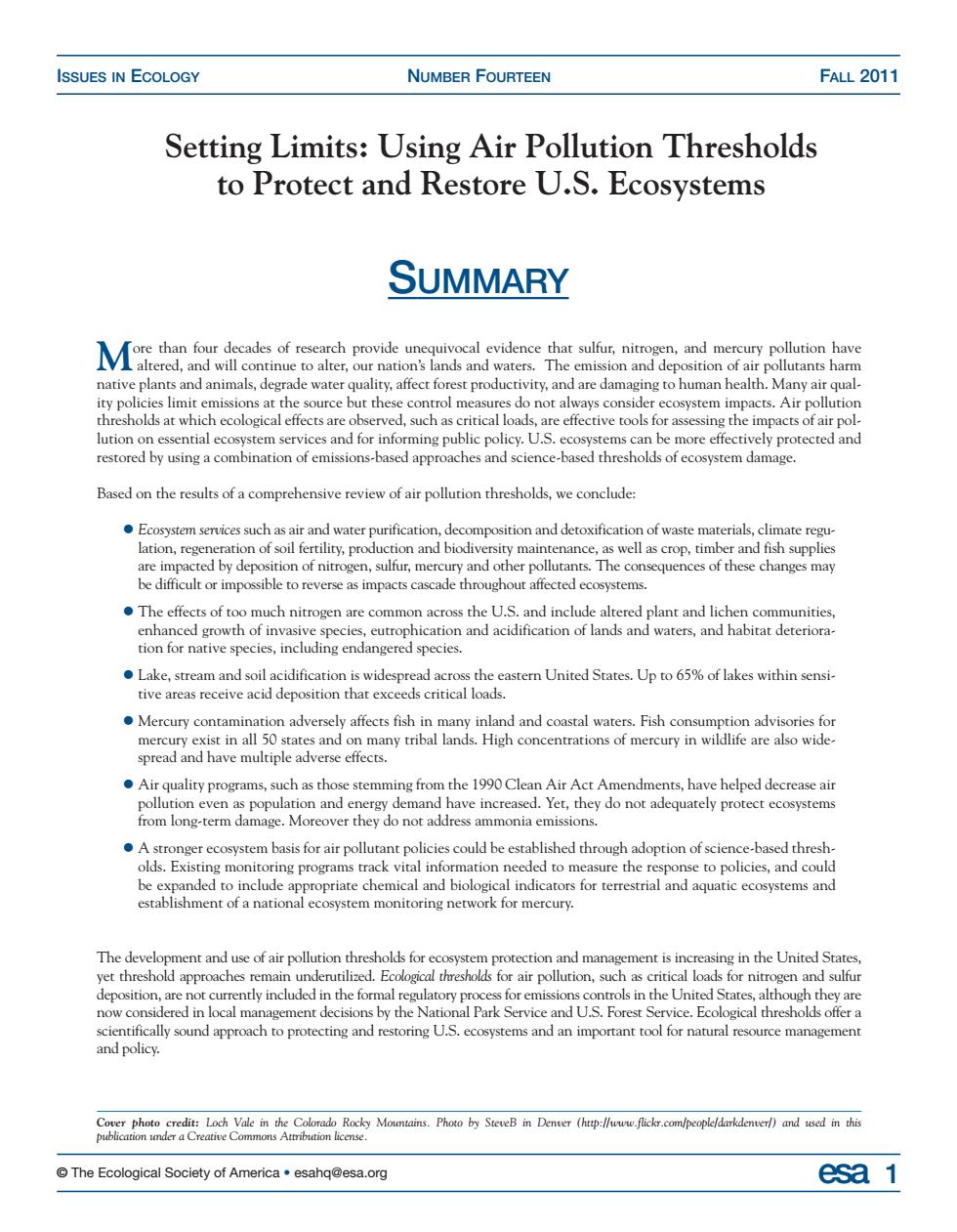正在加载图片...

ISSUES IN ECOLOGY NUMBER FOURTEEN FALL 2011 Setting Limits:Using Air Pollution Thresholds to Protect and Restore U.S.Ecosystems SUMMARY 之o lutionvicn forubi polyUbreero restored by usinga combination of emissions-based approaches and science-based thresholds of ecosystem damage. Based on the of a comprehensive review of air pollution thresholds,we concude: and water purificati nuch nitrogen are c d include altered am ntand tion for cid d eastern United S Up to65%of lakes within sensi Mercury contamination adversely affects fish in many inland and coastal waters.Fish consumption advisories for Air quality programs,such as those stemming from the 1990 Clean Air Act Amendments,have helped decrease air A stronger ecosystem basis for air pollutant policies could be established through adoption of science-based thresh olds.Existing monitoring programs track vital information needed to measure the response to policies,and could priate ch mical and biolog r terrestrial and aquatic ecosystems and 不ehn ss for emissio The Ecological Society of America.esahq@esa.org esa 1© The Ecological Society of America • esahq@esa.org esa 1 ISSUES IN ECOLOGY NUMBER FOURTEEN FALL 2011 Setting Limits: Using Air Pollution Thresholds to Protect and Restore U.S. Ecosystems SUMMARY More than four decades of research provide unequivocal evidence that sulfur, nitrogen, and mercury pollution have altered, and will continue to alter, our nation’s lands and waters. The emission and deposition of air pollutants harm native plants and animals, degrade water quality, affect forest productivity, and are damaging to human health. Many air quality policies limit emissions at the source but these control measures do not always consider ecosystem impacts. Air pollution thresholds at which ecological effects are observed, such as critical loads, are effective tools for assessing the impacts of air pollution on essential ecosystem services and for informing public policy. U.S. ecosystems can be more effectively protected and restored by using a combination of emissions-based approaches and science-based thresholds of ecosystem damage. Based on the results of a comprehensive review of air pollution thresholds, we conclude: l Ecosystem services such as air and water purification, decomposition and detoxification of waste materials, climate regulation, regeneration of soil fertility, production and biodiversity maintenance, as well as crop, timber and fish supplies are impacted by deposition of nitrogen, sulfur, mercury and other pollutants. The consequences of these changes may be difficult or impossible to reverse as impacts cascade throughout affected ecosystems. l The effects of too much nitrogen are common across the U.S. and include altered plant and lichen communities, enhanced growth of invasive species, eutrophication and acidification of lands and waters, and habitat deterioration for native species, including endangered species. l Lake, stream and soil acidification is widespread across the eastern United States. Up to 65% of lakes within sensitive areas receive acid deposition that exceeds critical loads. l Mercury contamination adversely affects fish in many inland and coastal waters. Fish consumption advisories for mercury exist in all 50 states and on many tribal lands. High concentrations of mercury in wildlife are also widespread and have multiple adverse effects. l Air quality programs, such as those stemming from the 1990 Clean Air Act Amendments, have helped decrease air pollution even as population and energy demand have increased. Yet, they do not adequately protect ecosystems from long-term damage. Moreover they do not address ammonia emissions. l A stronger ecosystem basis for air pollutant policies could be established through adoption of science-based thresholds. Existing monitoring programs track vital information needed to measure the response to policies, and could be expanded to include appropriate chemical and biological indicators for terrestrial and aquatic ecosystems and establishment of a national ecosystem monitoring network for mercury. The development and use of air pollution thresholds for ecosystem protection and management is increasing in the United States, yet threshold approaches remain underutilized. Ecological thresholds for air pollution, such as critical loads for nitrogen and sulfur deposition, are not currently included in the formal regulatory process for emissions controls in the United States, although they are now considered in local management decisions by the National Park Service and U.S. Forest Service. Ecological thresholds offer a scientifically sound approach to protecting and restoring U.S. ecosystems and an important tool for natural resource management and policy. Cover photo credit: Loch Vale in the Colorado Rocky Mountains. Photo by SteveB in Denver (http://www.flickr.com/people/darkdenver/) and used in this publication under a Creative Commons Attribution license